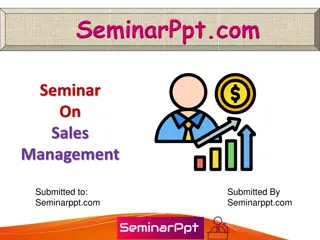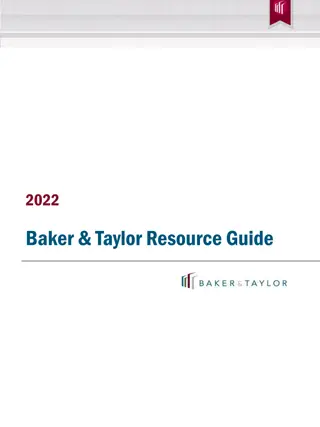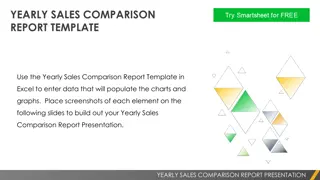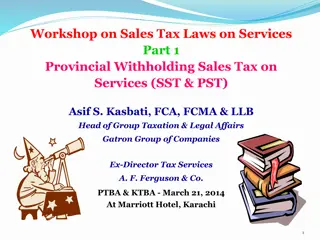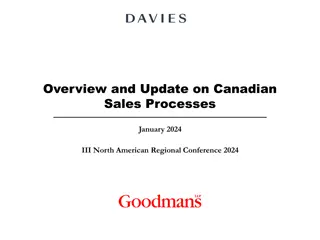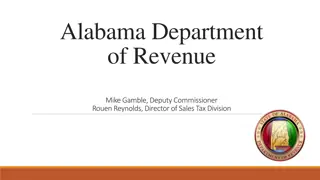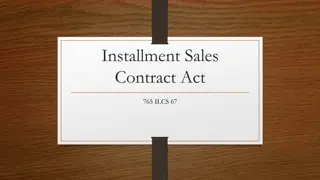
Understanding Installment Sales and Reporting Income
Explore the concept of installment sales, income components, reporting interest, and more. Learn how to handle installment sales effectively for tax purposes.
Download Presentation

Please find below an Image/Link to download the presentation.
The content on the website is provided AS IS for your information and personal use only. It may not be sold, licensed, or shared on other websites without obtaining consent from the author. If you encounter any issues during the download, it is possible that the publisher has removed the file from their server.
You are allowed to download the files provided on this website for personal or commercial use, subject to the condition that they are used lawfully. All files are the property of their respective owners.
The content on the website is provided AS IS for your information and personal use only. It may not be sold, licensed, or shared on other websites without obtaining consent from the author.
E N D
Presentation Transcript
Reporting Installment Sales and Repossessions GAIL ABBOTT, EA FOR BLUE RIDGE CHAPTER OF VIRGINIA SOCIETY OF ENROLLED AGENTS OCTOBER 19, 2016
What is an Installment Sale? Sale of Property where you receive at least one payment after the tax year of the sale. Installment Sales Method cannot be used for Sales of Inventory Dealer sales Special rule for time-shares and residential lots If Dealer elects to pay a special interest charge Stocks or Securities Losses
Installment Sale Income Each payment consists of three parts Interest Income Return of Adjusted Basis in Property Gain on the Sale
Installment Sale Income Each payment consists of three parts Interest Income Return of Adjusted Basis in Property Gain on the Sale
Interest Income Report interest as ordinary income Interest not generally included in down payment Subsequent payments generally have reportable interest, even if the agreement does not call for interest to be paid
Interest Income, Continued If agreement does not call for interest as part of the contract, reduce the stated selling price and increase the interest income by unstated interest amount Contract has adequate stated interest if the stated principal amount is at least equal to the sum of the present value of all principal and interest payments called for under the contract Present value is determined by the test rate of interest
Interest Income, Continued Test rate is the lower of the following applicable federal rates (AFRs) The lowest AFR in effect during the three month period ending with the first month in which there is a binding written contract The lowest AFR in effect during the three month period ending with the month in which the sale or exchange occurs AFR for 3 years or less, is the federal short term rate AFR for more than 3 but not more than 9 years is the federal mid- term rate AFR for more than 9years is the federal long-term rate
Installment Sale Income Each payment consists of three parts Interest Income Return of Adjusted Basis in Property Gain on the Sale
Calculating Basis How you figure basis depends on how you acquired the property If you bought the property, begin with cost - the amount you paid for the property If property was inherited, received as gift, built yourself or received in a tax-free exchange, basis is figured according to the rules governing that type of acquisition
Calculating Basis, continued Changes to basis Improvements Depreciation allowed or allowable Deductible casualty losses
Calculating Basis, continued Selling expenses add to basis Commissions Attorney s fees Other expenses paid on the sale
Depreciation Recapture Depreciation recapture must be reported in the year of sale whether or not an installment payment was received that year Depreciation recapture income includes Section 179 Figured in Part III of Form 4797 and reported in Part II of 4797 Ordinary Income Also reported in Part I of Form 6252 Gain greater than recapture income can be reported as installment sale income
Installment Sale Income Each payment consists of three parts Interest Income Return of Adjusted Basis in Property Gain on the Sale
Gain on Sale Gross Profit is total gain reported on the installment method Installment Sales price Minus Adjusted Basis Equals Gross Profit For Personal Residence, subtract any gain excludable from Gross Profit
Gain on Sale, Continued Gross Profit Percentage Gross Profit divided by contract price Contract price Selling price minus Mortgages, debts and other liabilities assumed or taken by the buyer plus The amount by which the mortgages, debts and liabilities assumed or take exceed adjusted basis for installment sale purposes See Part I of Form 6252
Disposition of an Installment Obligation If sold or exchanged, or you accept less than face value, your gain or loss is the difference between the basis in the obligation and the amount you realize If disposed of any other way, your gain or loss is the difference between your basis in the obligation and its FMV at the time of disposition
Disposition of an Installment Obligation Basis: multiply the unpaid balance on the obligation by your gross profit percentage. Subtract that from the unpaid balance. Result is your basis Transfer between spouses incident to divorce: no gain or loss recognized Gift: Gain or loss is the difference between basis and FMV at time of gift Cancellation: treated as disposition other than sale. If between related parties, FMV is considered to be no less than full face value. Transfer due to death: Not considered a disposition. Whoever receives the installment obligation treats it the same as seller would have had they lived to receive the payments
Repossession Must calculate both: Gain (or loss) on repossession Basis in repossessed property Different rules for personal property and real property Report gain or loss on same form used for original sale
Repossession of Personal Property 1 Enter FMV of Repossessed property 2. Enter unpaid balance of installment obligation 3. Gross profit percentage for installment sale 4. Multiply line 2 by line 3. Unrealized profit 5. Subtract line 4 from line 2. Basis of obligation 6. Repossession costs 7. Add lines 5 and 6 8. Subtract line 7 from line 1. Gain or loss on repossession.
Taxable Gain on Repossession of Real Property 1. Total of all payments received before repossession 2. Total gain already reported as income 3. Subtract line 2 from line 1. Gain on repossession 4. Gross Profit on original sale 5. Costs of repossessing property 6. Add line 2 and line 5 7. Subtract line 6 from line 4 8. Less of line 3 or line 7 Taxable gain on repossession
Basis of Repossessed Real Property 1. Unpaid balance on installment obligation 2. Gross Profit Percentage for sale 3. Multiply line 1 by line 2 4. Subtract line 3 from line 1. Adjusted basis in obligation at date of repossession 5. Taxable gain on repossession 6. Costs of repossessing property 7. Add lines 4, 5 and 6. Basis in repossessed property
Personal Residence Sale of personal residence can exclude gain of $250,000 ($500,00 MFJ) if conditions are met- IRC 121 Under regulation 1.1038-2, election to exclude is continued if repossessed property is re-sold within one year of repossession Sale and resale are treated as one transaction If original sale did not elect to exclude gain, treat as normal repossession If original sale was not eligible to exclude gain, treat as normal repossession
Personal Residence Re-determine adjusted basis and adjusted sale price Any adjustments reflect in income for taxable year in which re-sale occurs
Personal Residence Adjusted Sales Price = Amount realized on re-sale + Amount realized on original sale - Original Sale amounts unpaid - Repossession Costs - Fixing up costs both times
Personal Residence Adjusted Basis of Re-sale Adjusted basis at time of original sale Any adjustments to basis after re-acquisition Amount owed by original purchaser prior to reacquisition + - Any debt already expensed by taking bad debt deduction Reduction for bad debt cannot exceed increase for amount owed prior to reacquisition




